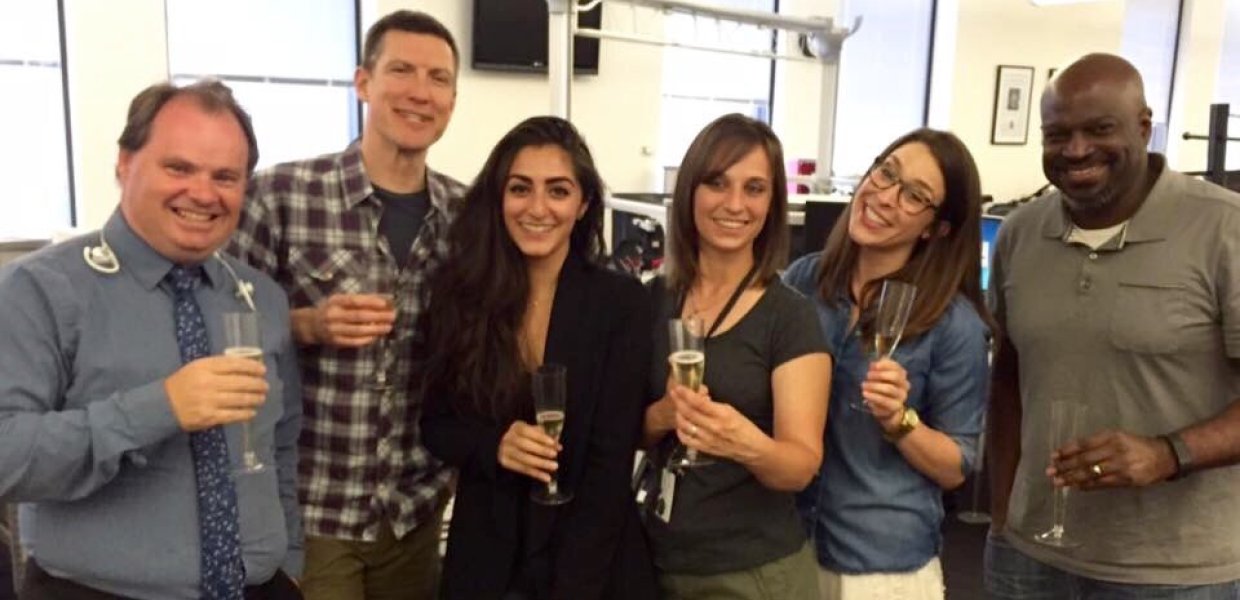At 11:58 a.m. on the morning of April 18, staff at the Los Angeles Times received an email directing them to the newsroom. This was no ordinary Monday morning meeting. It was Pulitzer Prize day, and within moments, clapping and cheers erupted as the news was announced via a livestream of the awards: the paper had won a Pulitzer.
“It was a totally euphoric moment,” said Laura Nelson (B.A. ‘12,) a USC Annenberg alumni and Times reporter. “It’s the best time ever to be in a newsroom.”
Nelson was among the five USC Annenberg alumni whose bylines were included in the reporting that won the team a breaking news Pulitzer Prize for “exceptional reporting, including both local and global perspectives, on the shooting in San Bernardino and the terror investigation that followed” last November.
The reporting of USC Annenberg alumni Sarah Parvini (M.A. ‘14), Matt Hamilton (M.A. ‘14), Kate Mather (B.A. ‘11), and Esmeralda Bermudez (B.A. ‘03) was also included.
Parvini was among the first Times reporters on the scene in San Bernardino, reporting from the Inland Regional Center, where the shooting occurred, and used her iPhone to live tweet and send information back to the newsroom.
“The result of our stream of feeds across platforms was a thorough story that had been updated more than 20 times throughout the day,” Parvini said. “It made us a destination for the latest on the attack and demonstrated the importance of digital-first news.”
Though normally a transportation reporter for the Times, Nelson was called upon that day to “catch feeds” from field reporters including Parvini, and to write up the information in articles for the Times website. The evening of the shooting, Nelson also attended a press conference in Orange County where she was able to speak with a relative of the shooters, and in the following week, she and other reporters worked to compile profiles of the victims.
In addition to the reporters, Nelson acknowledged the integral roles of editors and staff who contributed graphics, photography and ran the Times website, several of whom are also Annenberg alumni or faculty.
Writers Jerome Campbell (B.A. ‘14), Jack Leonard (M.A. ‘98), Shashank Bengali (B.A. ‘01), as well as Digital team editor John Adams (M.A. ‘10), digital editor Dan Watson (M.A. ‘12), deputy Metro editor Mary Ann Meek (B.A.) and Metro staff senior editor Steve Clow (B.A. '78) all contributed to the award-winning team’s work. USC Annenberg adjunct faculty who also contributed to the coverage were city editor Matt Lait and writer Ben Poston.
“The editors don’t get the bylines but they deserve so much credit for being the guiding forces and steady hands in our coverage,” Hamilton said.
Nelson noted the Pulitzer Prize-winning breaking news team is a young one. Many reporters are still in their 20s, and most of the USC Annenberg alumni graduated within the past 5 years.
“That older team members took the time and energy to show us the way speaks volumes about how bright the future of journalism is,” Nelson said. “Young people are still able to go out and get great reporting jobs. It’s really exciting.”
While an undergraduate at USC Annenberg, Nelson contributed to Neon Tommy, where she said she learned to think “web first.” But she acknowledged her professors at Annenberg as having been integral to her development as a reporter, recalling work with Diane Winston, Gabriel Kahn, and K.C. Cole, as well as adjuncts such as Scott Glover and Lait. Nelson said her education at Annenberg prepared her for a breaking news event like the San Bernardino shooting, where on-the-ground reporting skills are of critical importance.
“I’m really proud that so many members of the team went to USC,” Nelson said. “I think it’s a testament to the training we got there and education, not only at Annenberg but university-wide.”
For Mather, who was a Daily Trojan reporter during her time at USC, covering news alongside major Los Angeles news outlets as an undergraduate was instrumental in preparing her for her subsequent work at the Times.
“Part of the reason the Times was able to cover the San Bernardino attacks the way we did was because we had a team of reporters who had covered similar stories before,” Mather said. “We knew what had to be done — the people we needed to talk to, the doors we needed to knock on, the documents we needed to look for. That foundation was developed through real-world experience, including the experiences we had at USC.”
Parvini, who had no journalism experience prior to attending graduate school at USC Annenberg, where she was the deputy editor for Neon Tommy, also credited her Annenberg education with preparing her for covering such a monumental story.
“I saw my time at Annenberg as a microcosm for the journalism world at large,” Parvini said. “At USC, you could come to class, do what you were asked, write up your assignment and do just fine. But to do really well, to really make the most of it, you had to apply yourself and work hard. That’s true outside of Annenberg too. And it’s that kind of hard work and dedication from all the people on our San Bernardino team that helped the Times win the Pulitzer.”
